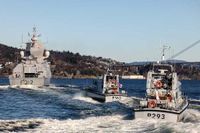The British and Norwegian navies have come together on Exercise TAMBER SHIELD, an important joint training mission taking place ahead of the Royal Navy’s significant Carrier Strike Group deployment.
On March 21, 2025, Norway officially committed the frigate Roald Amundsen and the tanker/support ship Maud to assist in this upcoming deployment, reinforcing their role as one of the UK’s closest defense partners in Europe. More than 200 Royal Navy personnel, alongside four Wildcat helicopters and four fast attack craft, spent an intensive three weeks near Bergen preparing for this major operation.
“Norwegian sailors and British helicopter crews are now ready to join the UK’s premier naval mission of 2025 after three weeks of intensive training in the fjords,” stated the UK Prime Minister, referencing the collaborative effort to enhance operational readiness. The exercise is now in its third year and has been key in developing various tactics aimed at defending the carrier group, ensuring both countries can work in close coordination in contested maritime environments.
Interestingly, instead of utilizing its usual NH90 helicopter, the Roald Amundsen will deploy a Royal Navy Wildcat, which is maintained and crewed by personnel from the 815 Naval Air Squadron. The integration exercises have seen British P2000 fast patrol boats and Norwegian missile craft maneuvering rapidly in the fjords, testing the larger ships’ ability to respond to threats.
In December 2024, the Prime Minister met with Norwegian counterpart Jonas Gahr Støre in Bergen to sign a historic new strategic partnership, solidifying defense cooperation between the two nations to counteract emerging threats, particularly from Russian activities in the region. The importance of this partnership cannot be understated, especially in a time when collective security across Europe is being emphasized.
Lieutenant Commander Oliver Brooksbank, Senior Pilot of the 815 Naval Air Squadron, remarked, “Previous iterations of the exercise laid the foundations with our Norwegian allies. Rehearsing maritime strike tactics using the Wildcat’s Martlet missile in Norway’s congested archipelago has been crucial. This year has built on those foundations and aims to ensure readiness to deploy alongside on operations in some of the most contested waters in the world.”
This sentiment was echoed by Commodore Kyrre Haugen, Norway’s Chief of the Naval Fleet, who noted that the extensive three-week training regimen provided “an exceptional arena for advanced integration training” between the Royal Navy and the Royal Norwegian Navy.
In further collaboration, the Royal Navy frigate Iron Duke, which has been activated 13 times in the past year to monitor contacts of interest—including recent Russian military activity—has also been actively participating in Norway. The vessel operated as part of a NATO task group in the Baltic region during winter months.
Arriving in Oslo, the Iron Duke's crew faced challenging conditions marked by poor visibility, sometimes down to just 50 yards. Lieutenant Simon Vernon, navigating officer of Iron Duke, commented on the melding of technology and skill during the challenging pilotage, showcasing the crew’s aptitude in using radar to navigate through the narrow channels of Oslo’s harbor.
The crew of Iron Duke has engaged in various training exercises, including capability demonstrations showcasing their operational readiness to local dignitaries and military officials. This included a successful mock response to hostile threats, reinforcing both the skill and readiness of the Royal Navy’s personnel.
Visitors to the demonstration included high-ranking officials such as the British Ambassador to Norway, Jan Thompson, and General Sir Gwyn Jenkins, Commandant General of the Royal Marines. Their presence underscored the significance of bilateral military cooperation.
Moreover, the training exercises involving the P2000s and the Wildcats from the Royal Navy’s Coastal Forces Squadron have tested advanced navigation techniques within the Norwegian fjords, aligning with the operational needs tied to the upcoming Carrier Strike deployment.
As both nations continue to develop their naval capabilities, an emphasis is placed on securing their collective northern flank, an area deemed critical as tensions in the region rise. The recent discussions between the UK’s Defence Secretary and his Norwegian counterpart aim to bring forth a new defence agreement, bolstering their ability to respond to threats and enhance collaboration across Europe.
“The hospitality and support from 334 Skvadron and Haakonsvern Naval Base has been superb, providing medical, engineering and logistical support as required,” said Lieutenant Jack Mason, Commanding Officer of Royal Navy fast patrol boat HMS Dasher. He highlighted the advanced navigation techniques developed during the exercises, equipping crews with essential skills for modern naval warfare.
As Exercise TAMBER SHIELD continues to yield positive results, both the Royal Navy and Royal Norwegian Navy stand ready to face future challenges, marking a new chapter in their long-standing partnership, with the aim of ensuring mutual security in a rapidly changing global context.

